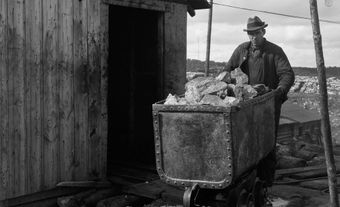Processing
Hydrogen sulphide is a highly toxic and corrosive component and is the main source of sulphur in Canada; most producing sour-gas fields contain 1% to 20% sulphur by weight. Hydrogen sulphide is recovered using a modified Claus process developed in the late 1880s by a German chemist, Carl Friederich Claus. The hydrogen sulphide is recovered by means of a chemical reaction and is fed to a furnace, where it passes through a condenser-converter series and is transformed into liquid sulphur. Most modified Claus systems remove up to 95% of the original sulphur content.
The first sour-gas recovery plant was built in 1951. Most sulphur recovery occurs in Alberta, and to a lesser degree in BC. Sulphur recovery from heavy oil upgrading occurs in Saskatchewan. Sulphur is also recovered from oil-sand processing and refining by the tar sands operations in northeastern Alberta. In eastern Canada, all sulphur production is derived from oil refining.
Liquid sulphur recovered from gas and oil facilities is either pumped to outside blocks, where it solidifies, to storage tanks for direct shipping in liquid form, or to slating, granulating or prilling plants. In the mid-1970s and again since the mid-1990s, declining sulphur exports have led to the development of sulphur stocks in the form of huge blocks spread among 20 locations, most of which are in Alberta. These blocks contained 21 million t of solidified sulphur in 1981, but were reduced to less than 3 million t in the early 1990s as world demand surpassed world production. Since 1993, production has been in excess of consumption; this surplus situation has led to the resumption of sulphur blocking in Alberta.
Sulphur products such as sulphuric acid (H2SO4) and sulphur dioxide (SO2) are also recovered from the smelting and refining of metallic sulphides. Effluent gas from smelting sulphide ores usually contains 1% to 12% sulphur dioxide. The processing of metallic sulphides for their sulphur content began in 1866. Early operations involved roasting pyrite (an Iron Ore, FeS2) for the production of sulphuric acid.
In the 1920s, use of base-metal smelter gases for the manufacture of by-product sulphuric acid began near Sudbury, Ont, and at Trail, BC. The largest smelter acid plant in Canada is operated by Inco LTD in Copper Cliff, Ont, where a 1 million t acid plant was commissioned in the early 1990s in a step to reduce its SO2 emissions. Since the mid-1980s, major efforts have been made by smelting companies in eastern Canada to reduce their emissions of sulphur dioxide into the atmosphere. In 1994, the 7 eastern provinces met their 1994 reduction target under the Eastern Canada Acid Rain Control Program. Emissions from smelters were 33% below their collective regulatory limit of 1.27 megatonnes per year.
Canadian Production
Canada is the world's second-largest producer of elemental sulphur after the US. Sulphur production in Canada is mostly dictated by gas production and related market factors; as such, sulphur recovery in Canada is deemed involuntary or nondiscretionary. Most of Canada's sulphur activity occurs in the oil sands. From the mid-1980s to the mid-1990s, gas production in Canada was buoyant due to strong demand in the domestic and export markets, generating important exploration, processing and pipeline investments in the gas sector in western Canada. During the same period, Canadian-recovered sulphur production rose by 40%.
Canada is the world's largest exporter of elemental sulphur, accounting for 40% of the world's sulphur trade. Canada sells sulphur to about 20 countries, including China, Brazil, South Africa, Mexico, Cuba, the US, Australia, Morocco, New Zealand and Israel.
See also Acid Rain; Bitumen; Chemical and Chemical Products Industries.

 Share on Facebook
Share on Facebook Share on X
Share on X Share by Email
Share by Email Share on Google Classroom
Share on Google Classroom


